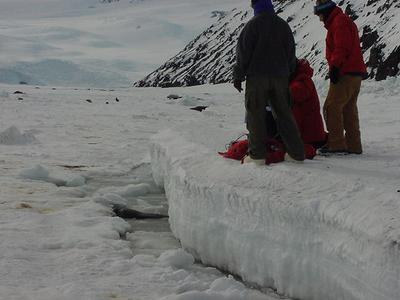9 November, 2000
FYI answer for 11/08/00
Sea ice is the frozen surface of the ocean. It melts with the spring and summer thaw and freezes with the fall and winter chill. During these changes, there is a larger increase in cracks and ice holes. The Ice Shelf is a massive ice sheet that is always attached to the continent. There are seasonal crack changes, but its movement is generally very slow over the years.
Big Razorback Island is the field camp for the United States Antarctic Program (USAP) Project BO-009. The project deals with the population dynamics, genetics, and behaviors of the Weddell Seals. My parcticipation in the TEA program centers on working with this project. Today I started that work. There are seven members of our team; Mike, Katsufumi, Yoko, Cory, Dan, Shawn and me. Four members spend the majority of their time taking a census of the population by tracking tags and tagging all previously untagged adults and pup seals. They also take tissue samples for DNA analysis. The other two members and I are more involved in the Weddell behaviors. Using cameras and data recorders that are attached to selected seals helps us to
do this.
The Weddell Seals can be found around the ice cracks near land formations. They use the crack that was created by nature as their doorway to the solid ice. Seals cannot live totally in the water. Females must have a stationary mass to have their pups. Ice holes give them this access. This time of year is when the females give birth. An adult female typically gives birth to one pup a year. There have been rare recordings of twin pups. They come up onto the ice, give birth, and stay with the pup for about seven weeks, with short times in which they will dive to get food and return to feed their pups. There is the mother instinct to know which pup she returns to because there re a large numbr of seals with pups in each area.
My first day of work happened to be the first 'Census Day'. All seven of us spread out in pairs to cover the entire eighty-five square miles and recorded seeing 1,100 of the approximate 1,400 seals in this main study area. We travel by snowmobiles and on foot. Our biggest danger was ice cracks. I fell into my first ice crack up to my waist. Luckily for me, the water only came up to my boot tops when I caught myself. After the shock wore off, I laughed. I was now officially christened. Mike, our team leader, told me it happens to somebody everyday.
FYI
It ____________ more on the outer continent or coastal areas than it does near the __________ ___________ and interior of _________________. The average snow accumulation is less than two __________ per year for the interior and thirty-five ___________ per year for the coastal areas.

They are cute now

This is called a pressure ridge

This is a tidal crack and many seals are found near tidal cracks

A Weddell mother and her pup
Contact the TEA in the field at
.
If you cannot connect through your browser, copy the
TEA's e-mail address in the "To:" line of
your favorite e-mail package.
|
